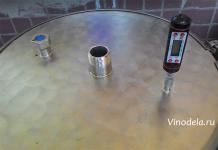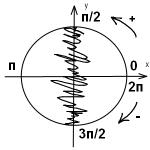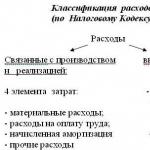Reduction formulas are relationships that allow you to go from sine, cosine, tangent and cotangent with angles `\frac (\pi)2 \pm \alpha`, `\pi \pm \alpha`, `\frac (3\pi) 2 \pm \alpha`, `2\pi \pm \alpha` to the same functions of the angle `\alpha`, which is located in the first quarter of the unit circle. Thus, the reduction formulas “lead” us to working with angles in the range from 0 to 90 degrees, which is very convenient.
All together there are 32 reduction formulas. They will undoubtedly come in handy during the Unified State Exam, exams, and tests. But let us immediately warn you that there is no need to memorize them! You need to spend a little time and understand the algorithm for their application, then it will not be difficult for you to derive the necessary equality at the right time.
First, let's write down all the reduction formulas:
For angle (`\frac (\pi)2 \pm \alpha`) or (`90^\circ \pm \alpha`):
`sin(\frac (\pi)2 - \alpha)=cos \ \alpha;` ` sin(\frac (\pi)2 + \alpha)=cos \ \alpha`
`cos(\frac (\pi)2 — \alpha)=sin \ \alpha;` ` cos(\frac (\pi)2 + \alpha)=-sin \ \alpha`
`tg(\frac (\pi)2 — \alpha)=ctg \ \alpha;` ` tg(\frac (\pi)2 + \alpha)=-ctg \ \alpha`
`ctg(\frac (\pi)2 — \alpha)=tg \ \alpha;` ` ctg(\frac (\pi)2 + \alpha)=-tg \ \alpha`
For angle (`\pi \pm \alpha`) or (`180^\circ \pm \alpha`):
`sin(\pi - \alpha)=sin \ \alpha;` ` sin(\pi + \alpha)=-sin \ \alpha`
`cos(\pi - \alpha)=-cos \ \alpha;` ` cos(\pi + \alpha)=-cos \ \alpha`
`tg(\pi - \alpha)=-tg \ \alpha;` ` tg(\pi + \alpha)=tg \ \alpha`
`ctg(\pi - \alpha)=-ctg \ \alpha;` ` ctg(\pi + \alpha)=ctg \ \alpha`
For angle (`\frac (3\pi)2 \pm \alpha`) or (`270^\circ \pm \alpha`):
`sin(\frac (3\pi)2 — \alpha)=-cos \ \alpha;` ` sin(\frac (3\pi)2 + \alpha)=-cos \ \alpha`
`cos(\frac (3\pi)2 — \alpha)=-sin \ \alpha;` ` cos(\frac (3\pi)2 + \alpha)=sin \ \alpha`
`tg(\frac (3\pi)2 — \alpha)=ctg \ \alpha;` ` tg(\frac (3\pi)2 + \alpha)=-ctg \ \alpha`
`ctg(\frac (3\pi)2 — \alpha)=tg \ \alpha;` ` ctg(\frac (3\pi)2 + \alpha)=-tg \ \alpha`
For angle (`2\pi \pm \alpha`) or (`360^\circ \pm \alpha`):
`sin(2\pi - \alpha)=-sin \ \alpha;` ` sin(2\pi + \alpha)=sin \ \alpha`
`cos(2\pi - \alpha)=cos \ \alpha;` ` cos(2\pi + \alpha)=cos \ \alpha`
`tg(2\pi - \alpha)=-tg \ \alpha;` ` tg(2\pi + \alpha)=tg \ \alpha`
`ctg(2\pi - \alpha)=-ctg \ \alpha;` ` ctg(2\pi + \alpha)=ctg \ \alpha`
You can often find reduction formulas in the form of a table where angles are written in radians:
To use it, we need to select the row with the function we need and the column with the desired argument. For example, to find out using a table what ` sin(\pi + \alpha)` will be equal to, it is enough to find the answer at the intersection of the row ` sin \beta` and the column ` \pi + \alpha`. We get ` sin(\pi + \alpha)=-sin \ \alpha`.
And the second, similar table, where angles are written in degrees:

Mnemonic rule for reduction formulas or how to remember them
As we already mentioned, there is no need to memorize all the above relationships. If you looked at them carefully, you probably noticed some patterns. They allow us to formulate a mnemonic rule (mnemonic - remember), with the help of which we can easily obtain any reduction formula.
Let us immediately note that to apply this rule you need to be good at identifying (or remembering) the signs of trigonometric functions in different quarters of the unit circle.  The vaccine itself contains 3 stages:
The vaccine itself contains 3 stages:
- The function argument must be represented as `\frac (\pi)2 \pm \alpha`, `\pi \pm \alpha`, `\frac (3\pi)2 \pm \alpha`, `2\pi \ pm \alpha`, and `\alpha` is necessarily an acute angle (from 0 to 90 degrees).
- For the arguments `\frac (\pi)2 \pm \alpha`, `\frac (3\pi)2 \pm \alpha` the trigonometric function of the transformed expression changes to a cofunction, that is, the opposite (sine to cosine, tangent to cotangent and vice versa). For arguments `\pi \pm \alpha`, `2\pi \pm \alpha` the function does not change.
- The sign of the original function is determined. The resulting function on the right side will have the same sign.
To see how this rule can be applied in practice, let’s transform several expressions:
1. `cos(\pi + \alpha)`.
The function is not reversed. The angle `\pi + \alpha` is in the third quarter, the cosine in this quarter has a “-” sign, so the transformed function will also have a “-” sign.
Answer: ` cos(\pi + \alpha)= - cos \alpha`
2. `sin(\frac (3\pi)2 - \alpha)`.
According to the mnemonic rule, the function will be reversed. The angle `\frac (3\pi)2 - \alpha` is in the third quarter, the sine here has a “-” sign, so the result will also have a “-” sign.
Answer: `sin(\frac (3\pi)2 - \alpha)= - cos \alpha`
3. `cos(\frac (7\pi)2 - \alpha)`.
`cos(\frac (7\pi)2 - \alpha)=cos(\frac (6\pi)2+\frac (\pi)2-\alpha)=cos (3\pi+(\frac(\pi )2-\alpha))`. Let's represent `3\pi` as `2\pi+\pi`. `2\pi` is the period of the function.
Important: The functions `cos \alpha` and `sin \alpha` have a period of `2\pi` or `360^\circ`, their values will not change if the argument is increased or decreased by these values.
Based on this, our expression can be written as follows: `cos (\pi+(\frac(\pi)2-\alpha)`. Applying the mnemonic rule twice, we get: `cos (\pi+(\frac(\pi) 2-\alpha)= - cos (\frac(\pi)2-\alpha)= - sin \alpha`.
Answer: `cos(\frac (7\pi)2 - \alpha)=- sin \alpha`.
Horse rule
The second point of the mnemonic rule described above is also called the horse rule of reduction formulas. I wonder why horses?
So, we have functions with arguments `\frac (\pi)2 \pm \alpha`, `\pi \pm \alpha`, `\frac (3\pi)2 \pm \alpha`, `2\pi \ pm \alpha`, points `\frac (\pi)2`, `\pi`, `\frac (3\pi)2`, `2\pi` are key, they are located on the coordinate axes. `\pi` and `2\pi` are on the horizontal x-axis, and `\frac (\pi)2` and `\frac (3\pi)2` are on the vertical ordinate.
We ask ourselves the question: “Does a function change into a cofunction?” To answer this question, you need to move your head along the axis on which the key point is located.
That is, for arguments with key points located on the horizontal axis, we answer “no” by shaking our heads to the sides. And for corners with key points located on the vertical axis, we answer “yes” by nodding our heads from top to bottom, like a horse :)
We recommend watching a video tutorial in which the author explains in detail how to remember reduction formulas without memorizing them.
Practical examples of using reduction formulas
The use of reduction formulas begins in grades 9 and 10. Many problems using them were submitted to the Unified State Exam. Here are some of the problems where you will have to apply these formulas:
- problems to solve a right triangle;
- transformation of numeric and alphabetic trigonometric expressions, calculation of their values;
- stereometric tasks.
Example 1. Calculate using reduction formulas a) `sin 600^\circ`, b) `tg 480^\circ`, c) `cos 330^\circ`, d) `sin 240^\circ`.
Solution: a) `sin 600^\circ=sin (2 \cdot 270^\circ+60^\circ)=-cos 60^\circ=-\frac 1 2`;
b) `tg 480^\circ=tg (2 \cdot 270^\circ-60^\circ)=ctg 60^\circ=\frac(\sqrt 3)3`;
c) `cos 330^\circ=cos (360^\circ-30^\circ)=cos 30^\circ=\frac(\sqrt 3)2`;
d) `sin 240^\circ=sin (270^\circ-30^\circ)=-cos 30^\circ=-\frac(\sqrt 3)2`.
Example 2. Having expressed cosine through sine using reduction formulas, compare the numbers: 1) `sin \frac (9\pi)8` and `cos \frac (9\pi)8`; 2) `sin \frac (\pi)8` and `cos \frac (3\pi)10`.
Solution: 1)`sin \frac (9\pi)8=sin (\pi+\frac (\pi)8)=-sin \frac (\pi)8`
`cos \frac (9\pi)8=cos (\pi+\frac (\pi)8)=-cos \frac (\pi)8=-sin \frac (3\pi)8`
`-sin \frac (\pi)8> -sin \frac (3\pi)8`
`sin \frac (9\pi)8>cos \frac (9\pi)8`.
2) `cos \frac (3\pi)10=cos (\frac (\pi)2-\frac (\pi)5)=sin \frac (\pi)5`
`sin \frac (\pi)8 `sin \frac (\pi)8 Let us first prove two formulas for the sine and cosine of the argument `\frac (\pi)2 + \alpha`: ` sin(\frac (\pi)2 + \alpha)=cos \ \alpha` and ` cos(\frac (\ pi)2 + \alpha)=-sin \ \alpha`. The rest are derived from them. Let's take a unit circle and point A on it with coordinates (1,0). Let after turning to Coming from the definition of tangent and cotangent, we obtain ` tan(\frac (\pi)2 + \alpha)=\frac (sin(\frac (\pi)2 + \alpha))(cos(\frac (\pi)2 + \alpha))=\frac (cos \alpha)(-sin \alpha)=-ctg \alpha` and ` сtg(\frac (\pi)2 + \alpha)=\frac (cos(\frac (\ pi)2 + \alpha))(sin(\frac (\pi)2 + \alpha))=\frac (-sin \alpha)(cos \alpha)=-tg \alpha`, which proves the reduction formulas for tangent and the cotangent of the angle `\frac (\pi)2 + \alpha`. To prove formulas with the argument `\frac (\pi)2 - \alpha`, it is enough to represent it as `\frac (\pi)2 + (-\alpha)` and follow the same path as above. For example, `cos(\frac (\pi)2 - \alpha)=cos(\frac (\pi)2 + (-\alpha))=-sin(-\alpha)=sin(\alpha)`. The angles `\pi + \alpha` and `\pi - \alpha` can be represented as `\frac (\pi)2 +(\frac (\pi)2+\alpha)` and `\frac (\pi) 2 +(\frac (\pi)2-\alpha)` respectively. And `\frac (3\pi)2 + \alpha` and `\frac (3\pi)2 - \alpha` as `\pi +(\frac (\pi)2+\alpha)` and `\pi +(\frac (\pi)2-\alpha)`. How not to memorize reduction formulas. When solving trigonometric equations or performing trigonometric transformations, the first step is to minimize the number of different arguments of trigonometric functions. To do this, you need to bring all the angles to the angles of the first quarter, using reduction formulas. I want to introduce you to a mnemonic rule that allows you to avoid memorizing. This rule is jokingly called the "Horse Rule". In this VIDEO TUTORIAL I will tell you how to use this rule: reduce the trigonometric function of an arbitrary angle to the angle of the first quarter, freeing yourself from the need to remember reduction formulas: So, " horse rule
" sounds like this: If we plot the angle from vertical axis, the horse says “yes” (we nod our head along the OY axis) and the reducible function changes its name: sine to cosine, cosine to sine, tangent to cotangent, cotangent to tangent.
If we plot the angle from horizontal axis, the horse says “no” (we nod our head along the OX axis) and the reduced function does not change its name.
The sign on the right side of the equality coincides with the sign of the reducible function on the left side of the equality.
Here are some examples of using reduction formulas: 1
. Find the meaning of the expression: 1. Select the whole part in the fraction: 2. Since the period of the function is equal to , let’s highlight the “idle speed”: Now our argument is in the range from zero to , and it's time to apply the "horse rule": To get to the point corresponding to the rotation angle by , we first make a rotation by radians, and then from this point we plot an angle of radians: 2
. Find the meaning of the expression: Let's look at each function separately: We first rotate by a radian and then make an angle of 1 radian from the vertical axis in the negative direction and end up in the third quarter: There are two rules for using reduction formulas. 1. If the angle can be represented as (π/2 ±a) or (3*π/2 ±a), then function name changes sin to cos, cos to sin, tg to ctg, ctg to tg. If the angle can be represented in the form (π ±a) or (2*π ±a), then The function name remains unchanged. Look at the picture below, it shows schematically when you should change the sign and when not. 2. The rule “as you were, so you remain.” The sign of the reduced function remains the same. If the original function had a plus sign, then the reduced function also has a plus sign. If the original function had a minus sign, then the reduced function also has a minus sign. The figure below shows the signs of the basic trigonometric functions depending on the quarter. Calculate Sin(150˚) Let's use the reduction formulas: Sin(150˚) is in the second quarter; from the figure we see that the sign of sin in this quarter is equal to +. This means that the given function will also have a plus sign. We applied the second rule. Now 150˚ = 90˚ +60˚. 90˚ is π/2. That is, we are dealing with the case π/2+60, therefore, according to the first rule, we change the function from sin to cos. As a result, we get Sin(150˚) = cos(60˚) = ½. If desired, all reduction formulas can be summarized in one table. But it’s still easier to remember these two rules and use them. Additional materials Teaching aids and simulators in the Integral online store for grade 10 What we will study: Review of trigonometric functions
Guys, you’ve already come across ghost formulas, but you haven’t called them that yet. What do you think: where? Look at our drawings. Correctly, when the definitions of trigonometric functions were introduced. Let's introduce the basic rule: If under the sign of the trigonometric function there is a number of the form π×n/2 + t, where n is any integer, then our trigonometric function can be reduced to a simpler form, which will contain only the argument t. Such formulas are called ghost formulas. Let's remember some formulas: there are a lot of ghost formulas, let's make a rule by which we will determine our trigonometric functions when using ghost formulas: These rules also apply when the function argument is given in degrees! We can also create a table of transformations of trigonometric functions: 1. Transform cos(π + t). The name of the function remains, i.e. we get cos(t). Let us further assume that π/2 2. Transform sin(π/2 + t). The name of the function changes, i.e. we get cos(t). Next, assume that 0 sin(t + π/2) = cos(t) 3. Transform tg(π + t). The name of the function remains, i.e. we get tan(t). Let us further assume that 0 4. Transform ctg(270 0 + t). The name of the function changes, that is, we get tg(t). Let us further assume that 0 Guys, convert it yourself using our rules: 1) tg(π + t), This article is devoted to a detailed study of trigonometric reduction formulas. A complete list of reduction formulas is given, examples of their use are shown, and proof of the correctness of the formulas is given. The article also provides a mnemonic rule that allows you to derive reduction formulas without memorizing each formula. Yandex.RTB R-A-339285-1 Reduction formulas allow you to reduce basic trigonometric functions of angles of arbitrary magnitude to functions of angles lying in the range from 0 to 90 degrees (from 0 to π 2 radians). Operating with angles from 0 to 90 degrees is much more convenient than working with arbitrarily large values, which is why reduction formulas are widely used in solving trigonometry problems. Before we write down the formulas themselves, let us clarify several important points for understanding. Now let's move directly to the reduction formulas. Reduction formulas allow you to move from working with arbitrary and arbitrarily large angles to working with angles ranging from 0 to 90 degrees. Let's write all the formulas in table form. Reduction formulas sin α + 2 π z = sin α , cos α + 2 π z = cos α t g α + 2 π z = t g α , c t g α + 2 π z = c t g α sin - α + 2 π z = - sin α , cos - α + 2 π z = cos α t g - α + 2 π z = - t g α , c t g - α + 2 π z = - c t g α sin π 2 + α + 2 π z = cos α , cos π 2 + α + 2 π z = - sin α t g π 2 + α + 2 π z = - c t g α , c t g π 2 + α + 2 π z = - t g α sin π 2 - α + 2 π z = cos α , cos π 2 - α + 2 π z = sin α t g π 2 - α + 2 π z = c t g α , c t g π 2 - α + 2 π z = t g α sin π + α + 2 π z = - sin α , cos π + α + 2 π z = - cos α t g π + α + 2 π z = t g α , c t g π + α + 2 π z = c t g α sin π - α + 2 π z = sin α , cos π - α + 2 π z = - cos α t g π - α + 2 π z = - t g α , c t g π - α + 2 π z = - c t g α sin 3 π 2 + α + 2 π z = - cos α , cos 3 π 2 + α + 2 π z = sin α t g 3 π 2 + α + 2 π z = - c t g α , c t g 3 π 2 + α + 2 π z = - t g α sin 3 π 2 - α + 2 π z = - cos α , cos 3 π 2 - α + 2 π z = - sin α t g 3 π 2 - α + 2 π z = c t g α , c t g 3 π 2 - α + 2 π z = t g α In this case, the formulas are written in radians. However, you can also write them using degrees. It is enough just to convert radians to degrees, replacing π by 180 degrees. We will show how to use reduction formulas and how these formulas are used to solve practical examples. The angle under the sign of the trigonometric function can be represented not in one, but in many ways. For example, the argument of a trigonometric function can be represented in the form ± α + 2 π z, π 2 ± α + 2 π z, π ± α + 2 π z, 3 π 2 ± α + 2 π z. Let's demonstrate this. Let's take the angle α = 16 π 3. This angle can be written like this: α = 16 π 3 = π + π 3 + 2 π 2 α = 16 π 3 = - 2 π 3 + 2 π 3 α = 16 π 3 = 3 π 2 - π 6 + 2 π Depending on the representation of the angle, the appropriate reduction formula is used. Let's take the same angle α = 16 π 3 and calculate its tangent Example 1: Using reduction formulas α = 16 π 3 , t g α = ? Let us represent the angle α = 16 π 3 as α = π + π 3 + 2 π 2 This representation of the angle will correspond to the reduction formula t g (π + α + 2 π z) = t g α t g 16 π 3 = t g π + π 3 + 2 π 2 = t g π 3 Using the table, we indicate the value of the tangent Now we use another representation of the angle α = 16 π 3. Example 2: Using reduction formulas α = 16 π 3 , t g α = ? α = - 2 π 3 + 2 π 3 t g 16 π 3 = t g - 2 π 3 + 2 π 3 = - t g 2 π 3 = - (- 3) = 3 Finally, for the third representation of the angle we write Example 3. Using reduction formulas α = 16 π 3 = 3 π 2 - π 6 + 2 π t g 3 π 2 - α + 2 π z = c t g α t g α = t g (3 π 2 - π 6 + 2 π) = c t g π 6 = 3 Now let's give an example of using more complex reduction formulas Example 4: Using reduction formulas Let's imagine sin 197° through the sine and cosine of an acute angle. In order to be able to apply reduction formulas, you need to represent the angle α = 197 ° in one of the forms ± α + 360 ° z, 90 ° ± α + 360 ° z, 180 ° ± α + 360 ° z, 270 ° ± α + 360 ° z. According to the conditions of the problem, the angle must be acute. Accordingly, we have two ways to represent it: 197° = 180° + 17° 197° = 270° - 73° We get sin 197° = sin (180° + 17°) sin 197° = sin (270° - 73°) Now let's look at the reduction formulas for sines and choose the appropriate ones sin (π + α + 2 πz) = - sinα sin (3 π 2 - α + 2 πz) = - cosα sin 197 ° = sin (180 ° + 17 ° + 360 ° z) = - sin 17 ° sin 197 ° = sin (270 ° - 73 ° + 360 ° z) = - cos 73 ° There are many reduction formulas, and, fortunately, there is no need to memorize them. There are regularities by which reduction formulas can be derived for different angles and trigonometric functions. These patterns are called mnemonic rules. Mnemonics is the art of memorization. The mnemonic rule consists of three parts, or contains three stages. Mnemonic rule 1. The argument of the original function is represented in one of the following forms: ± α + 2 πz π 2 ± α + 2 πz π ± α + 2 πz 3 π 2 ± α + 2 πz Angle α must lie between 0 and 90 degrees. 2. The sign of the original trigonometric function is determined. The function written on the right side of the formula will have the same sign. 3. For angles ± α + 2 πz and π ± α + 2 πz the name of the original function remains unchanged, and for angles π 2 ± α + 2 πz and 3 π 2 ± α + 2 πz, respectively, it changes to “cofunction”. Sine - cosine. Tangent - cotangent. To use the mnemonic guide for reduction formulas, you need to be able to determine the signs of trigonometric functions based on the quarters of the unit circle. Let's look at examples of using the mnemonic rule. Example 1: Using a mnemonic rule Let us write down the reduction formulas for cos π 2 - α + 2 πz and t g π - α + 2 πz. α is the log of the first quarter. 1. Since by condition α is the log of the first quarter, we skip the first point of the rule. 2. Determine the signs of the functions cos π 2 - α + 2 πz and t g π - α + 2 πz. The angle π 2 - α + 2 πz is also the angle of the first quarter, and the angle π - α + 2 πz is in the second quarter. In the first quarter, the cosine function is positive, and the tangent in the second quarter has a minus sign. Let's write down what the required formulas will look like at this stage. cos π 2 - α + 2 πz = + t g π - α + 2 πz = - 3. According to the third point, for the angle π 2 - α + 2 π the name of the function changes to Confucius, and for the angle π - α + 2 πz remains the same. Let's write down: cos π 2 - α + 2 πz = + sin α t g π - α + 2 πz = - t g α Now let’s look at the formulas given above and make sure that the mnemonic rule works. Let's look at an example with a specific angle α = 777°. Let us reduce sine alpha to the trigonometric function of an acute angle. Example 2: Using a mnemonic rule 1. Imagine the angle α = 777 ° in the required form 777° = 57° + 360° 2 777° = 90° - 33° + 360° 2 2. The original angle is the angle of the first quarter. This means that the sine of the angle has a positive sign. As a result we have: 3. sin 777° = sin (57° + 360° 2) = sin 57° sin 777° = sin (90° - 33° + 360° 2) = cos 33° Now let's look at an example that shows how important it is to correctly determine the sign of the trigonometric function and correctly represent the angle when using the mnemonic rule. Let's repeat it again. Important! Angle α must be acute! Let's calculate the tangent of the angle 5 π 3. From the table of values of the main trigonometric functions, you can immediately take the value t g 5 π 3 = - 3, but we will apply the mnemonic rule. Example 3: Using a mnemonic rule Let's imagine the angle α = 5 π 3 in the required form and use the rule t g 5 π 3 = t g 3 π 2 + π 6 = - c t g π 6 = - 3 t g 5 π 3 = t g 2 π - π 3 = - t g π 3 = - 3 If we represent the alpha angle in the form 5 π 3 = π + 2 π 3, then the result of applying the mnemonic rule will be incorrect. t g 5 π 3 = t g π + 2 π 3 = - t g 2 π 3 = - (- 3) = 3 The incorrect result is due to the fact that the angle 2 π 3 is not acute. The proof of the reduction formulas is based on the properties of periodicity and symmetry of trigonometric functions, as well as on the property of shift by angles π 2 and 3 π 2. The proof of the validity of all reduction formulas can be carried out without taking into account the term 2 πz, since it denotes a change in the angle by an integer number of full revolutions and precisely reflects the property of periodicity. The first 16 formulas follow directly from the properties of the basic trigonometric functions: sine, cosine, tangent and cotangent. Here is a proof of the reduction formulas for sines and cosines sin π 2 + α = cos α and cos π 2 + α = - sin α Let's look at a unit circle, the starting point of which, after a rotation through an angle α, goes to the point A 1 x, y, and after a rotation through an angle π 2 + α - to a point A 2. From both points we draw perpendiculars to the abscissa axis. Two right triangles O A 1 H 1 and O A 2 H 2 are equal in hypotenuse and adjacent angles. From the location of points on the circle and the equality of triangles, we can conclude that point A 2 has coordinates A 2 - y, x. Using the definitions of sine and cosine, we write: sin α = y, cos α = x, sin π 2 + α = x, cos π 2 + α = y sin π 2 + α = cos α, cos π 2 + α = - sin α Taking into account the basic identities of trigonometry and what has just been proven, we can write t g π 2 + α = sin π 2 + α cos π 2 + α = cos α - sin α = - c t g α c t g π 2 + α = cos π 2 + α sin π 2 + α = - sin α cos α = - t g α To prove reduction formulas with argument π 2 - α, it must be presented in the form π 2 + (- α). For example: cos π 2 - α = cos π 2 + (- α) = - sin (- α) = sin α The proof uses the properties of trigonometric functions with arguments of opposite signs. All other reduction formulas can be proven based on those written above. If you notice an error in the text, please highlight it and press Ctrl+Enter angle `\alpha` it will go to point `A_1(x, y)`, and after turning by angle `\frac (\pi)2 + \alpha` to point `A_2(-y, x)`. Dropping the perpendiculars from these points to the line OX, we see that the triangles `OA_1H_1` and `OA_2H_2` are equal, since their hypotenuses and adjacent angles are equal. Then, based on the definitions of sine and cosine, we can write `sin \alpha=y`, `cos \alpha=x`, `sin(\frac (\pi)2 + \alpha)=x`, `cos(\frac (\ pi)2 + \alpha)=-y`. Where can we write that ` sin(\frac (\pi)2 + \alpha)=cos \alpha` and ` cos(\frac (\pi)2 + \alpha)=-sin \alpha`, which proves the reduction formulas for sine and cosine angles `\frac (\pi)2 + \alpha`.
angle `\alpha` it will go to point `A_1(x, y)`, and after turning by angle `\frac (\pi)2 + \alpha` to point `A_2(-y, x)`. Dropping the perpendiculars from these points to the line OX, we see that the triangles `OA_1H_1` and `OA_2H_2` are equal, since their hypotenuses and adjacent angles are equal. Then, based on the definitions of sine and cosine, we can write `sin \alpha=y`, `cos \alpha=x`, `sin(\frac (\pi)2 + \alpha)=x`, `cos(\frac (\ pi)2 + \alpha)=-y`. Where can we write that ` sin(\frac (\pi)2 + \alpha)=cos \alpha` and ` cos(\frac (\pi)2 + \alpha)=-sin \alpha`, which proves the reduction formulas for sine and cosine angles `\frac (\pi)2 + \alpha`.![]()
![]()
 We plotted the angle from the horizontal axis (the horse says “no”) - it does not change its name, the angle is located in the third quarter, in which the cosine is negative, therefore the reduced function is negative. We get:
We plotted the angle from the horizontal axis (the horse says “no”) - it does not change its name, the angle is located in the third quarter, in which the cosine is negative, therefore the reduced function is negative. We get:![]()
![]()
 Consequently, the reducible function changes its name, the reducible function is greater than zero (the tangent of the third quarter angle is greater than zero):
Consequently, the reducible function changes its name, the reducible function is greater than zero (the tangent of the third quarter angle is greater than zero): ![]() .
. First we make a turn by a radian, and then from this point we move by 1 radian in a negative direction. We set aside an angle of 1 radian from the horizontal axis (the sine does not change its name) and find ourselves in the second quarter, in which the sine is greater than zero:
First we make a turn by a radian, and then from this point we move by 1 radian in a negative direction. We set aside an angle of 1 radian from the horizontal axis (the sine does not change its name) and find ourselves in the second quarter, in which the sine is greater than zero:
Need help with your studies?

Previous topic: Lesson and presentation on the topic: "Application of reduction formulas in solving problems"
Dear users, do not forget to leave your comments, reviews, wishes. All materials have been checked by an anti-virus program.
1C: School. Interactive construction tasks for grades 7-10
1C: School. We solve problems in geometry. Interactive tasks on building in space for grades 10–11
1. Let's repeat a little.
2. Rules for reduction formulas.
3. Conversion table for reduction formulas.
4. Examples.Rule for reduction formulas
3π/2 + t and 3π/2 - t, then the function will change to a related one, that is, the sine will become a cosine, the cotangent will become a tangent.
Examples of using reduction formulas




Problems with reduction formulas for independent solution
2) tg(2π - t),
3) cot(π - t),
4) tg(π/2 - t),
5) cotg(3π + t),
6) sin(2π + t),
7) sin(π/2 + 5t),
8) sin(π/2 - t),
9) sin(2π - t),
10) cos(2π - t),
11) cos(3π/2 + 8t),
12) cos(3π/2 - t),
13) cos(π - t).Reduction formulas. List
Examples of using reduction formulas
Mnemonic rule


















